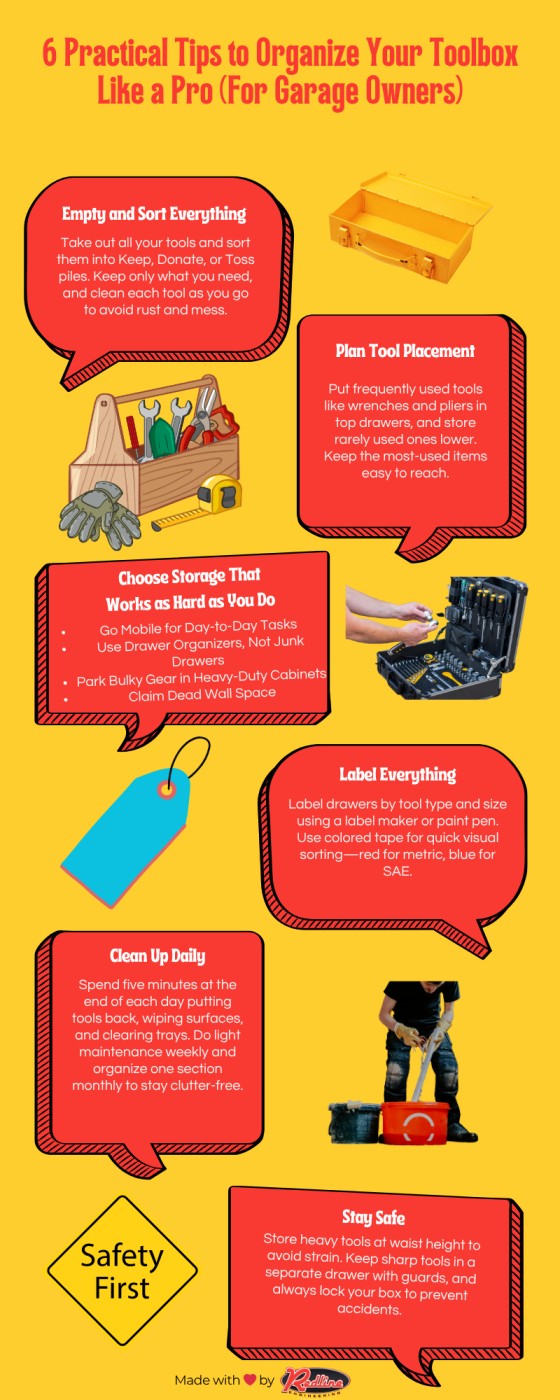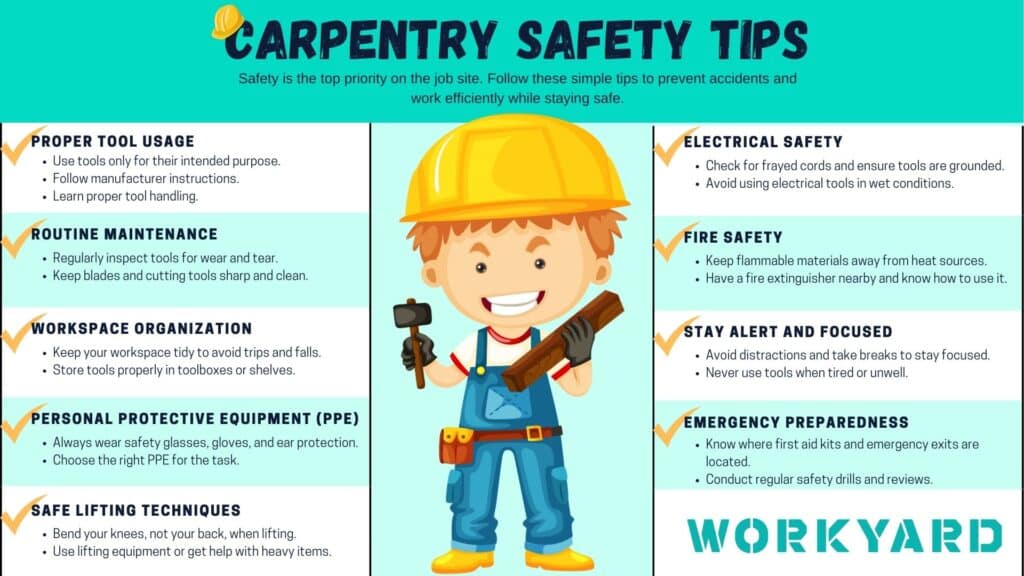If you’re new to using tools, safety should be your top priority. One wrong move can lead to serious injury or damage.
But don’t worry—learning a few simple safety tips can keep you protected and confident every time you pick up a tool. You’ll discover easy-to-follow advice that will help you avoid common mistakes and work smarter, not harder. Keep reading to make sure your next project is safe and successful.
Choosing The Right Tools
Using the right tools is very important for safety. Beginners should pick tools that fit their needs and skills.
Good tools make work easier and reduce the chance of accidents. Choosing carefully helps you stay safe.
Selecting Tools For Your Skill Level
Pick tools that match what you can do. Simple tools work best if you are new.
Avoid tools that need special training or skills you do not have yet. Start small and learn step by step.
- Choose tools with easy controls
- Look for clear instructions
- Pick tools that feel comfortable
- Ask for help if unsure
Quality Vs. Budget Considerations
Good quality tools last longer and work better. Cheap tools may break or cause accidents.
Buy the best tools you can afford. This helps keep you safe and saves money in the long run.
- Check reviews before buying
- Look for safety features
- Spend more on essential tools
- Save on less used tools

Credit: www.redlinestands.com
Personal Protective Equipment
Using tools can be dangerous without the right safety gear. Personal protective equipment (PPE) helps protect you from injuries. Beginners should always wear proper PPE to stay safe.
PPE includes items like gloves, goggles, and helmets. These tools shield your body from cuts, dust, and impacts. Always prepare with PPE before starting any tool work.
Essential Safety Gear
Some safety gear is a must when using tools. It protects your eyes, ears, hands, and head from harm. Never skip wearing these items during work.
- Safety goggles to protect your eyes from flying debris
- Ear protection like earplugs or earmuffs to reduce noise
- Gloves to shield your hands from cuts and splinters
- Hard hats to protect your head from falling objects
- Respirators or masks to avoid breathing dust or fumes
- Steel-toe boots to guard your feet from heavy tools
Proper Fit And Maintenance
Safety gear must fit well to work properly. Loose or tight equipment can cause accidents. Try on your PPE before use to ensure comfort and protection.
Keep your gear clean and in good shape. Check for cracks, tears, or wear before every use. Replace damaged equipment right away to stay safe.
- Check goggles for scratches or cracks
- Clean gloves after use and check for holes
- Ensure ear protection fits snugly over ears
- Inspect hard hats for dents or damage
- Store respirators in a dry, clean place
- Replace worn-out boots or soles
Tool Inspection And Maintenance
Keeping your tools in good shape is important for safe work. Regular inspection and maintenance help tools last longer.
Check your tools before use to find any problems early. Proper care keeps you safe and your tools ready.
Checking For Damage
Look closely at each tool before using it. Find cracks, rust, or loose parts that could cause accidents.
Stop using any tool that shows damage. Fix it or replace it to avoid injuries.
- Inspect handles for splits or cracks
- Check blades or edges for dullness or chips
- Look for rust or corrosion on metal parts
- Ensure moving parts work smoothly without looseness
- Test electrical tools for frayed cords or sparks
Cleaning And Storage Tips
Clean tools after every use to remove dirt and debris. This prevents damage and keeps tools working well.
Store tools in a dry, safe place. Organize them so you can find and use them easily next time.
- Wipe tools with a clean cloth after use
- Use oil to protect metal parts from rust
- Keep tools in a toolbox or on a pegboard
- Avoid leaving tools outside or in damp areas
- Label storage spaces to keep tools organized
Safe Handling Techniques
Using tools safely is very important for beginners. Knowing how to hold and use tools lowers the chance of injury.
Good habits keep you safe and help you work better. Learn how to handle tools the right way.
Correct Grip And Posture
Hold tools firmly but not too tight. A strong grip helps control the tool without causing hand strain.
Stand or sit with a straight back. Keep your feet shoulder-width apart for good balance.
- Use both hands if the tool is heavy or large
- Keep your wrists straight to avoid injury
- Position your body close to the work area
- Keep elbows near your body for better control
Avoiding Common Mistakes
Do not rush when using tools. Moving too fast can cause accidents and mistakes.
Always check tools before use. Look for cracks, loose parts, or dull blades that can be dangerous.
- Never use tools with damaged handles or blades
- Do not use excessive force to make tools work
- Keep your work area clean and free of clutter
- Wear safety gear like gloves and eye protection
Work Area Safety
Keeping your work area safe is very important when using tools. A clean and organized space helps prevent accidents.
Good safety habits protect you and others from injuries. Always pay attention to your surroundings.
Keeping The Workspace Organized
Organize tools and materials before starting work. This reduces the risk of tripping or knocking things over.
Put tools back in their place after use. A tidy workspace helps you find items quickly and stay safe.
- Clear clutter from floors and benches
- Use toolboxes or racks to store tools
- Label storage areas for easy identification
- Keep cords and wires untangled and out of walkways
Managing Distractions
Stay focused while using tools. Distractions can cause mistakes and accidents.
Turn off devices or noises that may interrupt your work. Keep your attention on the task.
- Work in a quiet area if possible
- Inform others not to disturb you during work
- Take breaks to rest your mind and body
- Avoid multitasking when handling tools

Credit: www.safetyandhealthmagazine.com
Power Tool Safety
Power tools are helpful but can be dangerous if not used right. Learning safety tips keeps you safe and prevents accidents.
Always pay attention and follow safety rules when using any power tool. Safety is the first step to work well.
Using Power Tools Correctly
Read the manual before using a power tool. Know how it works and what safety features it has.
Wear safety gear like goggles, gloves, and ear protection. Keep your hands and body parts away from moving parts.
- Check the tool for damage before use
- Use the right tool for the job
- Keep the work area clean and well-lit
- Hold tools firmly and use both hands if possible
- Turn off and unplug tools when changing bits or blades
Electrical Safety Measures
Inspect cords and plugs for cuts or frays before using power tools. Damaged cords can cause electric shocks.
Use power tools with a ground-fault circuit interrupter (GFCI) to prevent electric shocks. Never use tools in wet areas.
- Do not overload electrical outlets
- Keep cords away from heat, oil, and sharp edges
- Unplug tools before cleaning or fixing them
- Use extension cords rated for outdoor use if needed
- Always dry your hands before handling electric tools
Emergency Preparedness
Using tools can be risky if you are not ready for emergencies. Knowing what to do can save lives and prevent serious injuries.
It is important to prepare before using any tool. Keep first aid supplies nearby and learn basic emergency steps.
First Aid Basics
First aid helps you treat injuries right away. It can reduce pain and stop problems from getting worse.
Keep a first aid kit with bandages, antiseptic wipes, and gloves. Know how to use each item safely.
- Stop bleeding by pressing on the wound
- Clean cuts with clean water or antiseptic
- Cover wounds with sterile bandages
- Use gloves to protect yourself and others
- Keep calm and call for help if needed
Responding To Tool-related Injuries
If you or someone else gets hurt by a tool, act quickly. Check the injury and give first aid if possible.
Call emergency services if the injury is serious. Stay with the person and keep them calm until help arrives.
- Do not move the injured person unless necessary
- Keep the injured area still and elevated if possible
- Use clean cloths to cover wounds
- Watch for signs of shock, like pale skin or weakness
- Provide clear information to emergency responders
Learning And Practice
Using tools safely is very important, especially for beginners. Learning how to use tools correctly helps prevent accidents.
Practicing with tools builds confidence and skill. Taking time to learn will keep you and others safe.
Following Manufacturer Instructions
Always read the tool’s manual before use. The manufacturer explains how to use the tool safely.
Instructions include safety tips, maintenance, and the right way to operate the tool. Ignoring them can cause injury or damage.
- Check for warnings and safety signs
- Use recommended safety gear
- Follow the cleaning and storage advice
- Use the tool only for its intended purpose
Seeking Professional Guidance
Ask an expert if you feel unsure about using a tool. Professionals can show you the correct way to handle tools.
Watching someone experienced can teach you safe habits and tips that manuals may not explain well.
- Attend workshops or classes
- Ask for help at hardware stores
- Watch tutorials from trusted professionals
- Practice under supervision when possible

Credit: www.youtube.com
Frequently Asked Questions
What Are Essential Safety Tips For Beginners Using Tools?
Always wear protective gear like gloves and goggles. Read the tool manual carefully. Keep your workspace clean and well-lit. Use tools only for their intended purpose. Inspect tools for damage before use to prevent accidents.
How Can Beginners Avoid Common Tool Injuries?
Maintain a firm grip and proper posture. Never rush or force a tool. Keep fingers away from moving parts. Disconnect power tools when not in use. Store tools safely to avoid trips or falls.
Why Is Tool Maintenance Important For Beginners?
Proper maintenance ensures tools work efficiently and safely. Regular cleaning removes debris that can cause malfunctions. Sharp blades reduce effort and increase precision. Lubrication prevents rust and wear. Well-maintained tools last longer and reduce accident risks.
What Personal Protective Equipment Is Necessary For Tool Safety?
Wear safety goggles to protect eyes from debris. Use gloves to prevent cuts and splinters. Hearing protection is vital for loud power tools. Wear sturdy shoes to protect feet. Always use masks when working with dust or fumes.
Conclusion
Tool safety is crucial for beginners. Safety prevents accidents and ensures smooth work. Always wear protective gear. Read tool manuals carefully. Practice proper handling techniques. Keep your workspace organized. Regularly maintain and inspect your tools. Avoid distractions when working. Stay focused and alert at all times.
These habits build confidence and skill. Safety should always come first. Start with these tips and grow your expertise. Safe practices lead to better results and a more enjoyable experience. Remember, safe work is successful work. Happy and safe tool handling!
10 min read

